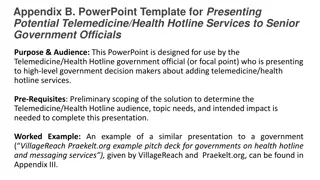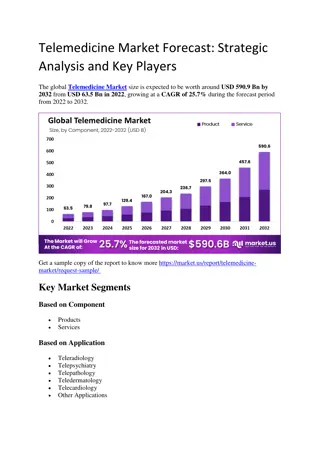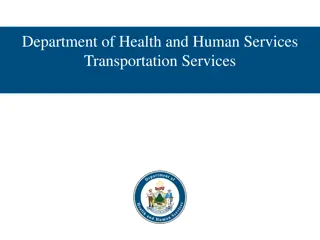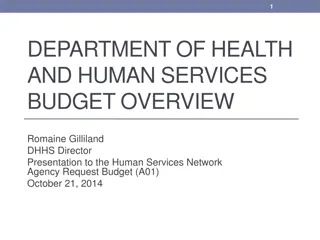
Telemedicine Policy Implementation in South Carolina - A Case Study
Discover how South Carolina addressed healthcare needs in rural communities through telemedicine, highlighting the key factors driving policy changes and the collaborative efforts that led to successful implementation of telehealth services in the state.
Download Presentation

Please find below an Image/Link to download the presentation.
The content on the website is provided AS IS for your information and personal use only. It may not be sold, licensed, or shared on other websites without obtaining consent from the author. If you encounter any issues during the download, it is possible that the publisher has removed the file from their server.
You are allowed to download the files provided on this website for personal or commercial use, subject to the condition that they are used lawfully. All files are the property of their respective owners.
The content on the website is provided AS IS for your information and personal use only. It may not be sold, licensed, or shared on other websites without obtaining consent from the author.
E N D
Presentation Transcript
Health Students, Promising Future Learning Collaborative Digging in Deep: Telehealth Valeria Williams Program Director, DHHS Health Programs June 14, 2018
Agenda Medicaid Perspective - SC Department of Health and Human Services, Valeria Williams, Program Director Coordination and Collaboration SC Department of Education, Shelley McGeorge, Ph.D., MPA, LPC/S, LMFT, Director of Medicaid Services Steps Needed to Build from Smaller to Larger State- supported Telehealth Efforts - Medical University of South Carolina, Elana N. Wells, MPH, CHES, School- Based Health Manager, Center for Telehealth 2
Why Telemedicine South Carolina (SC) had a documented and demonstrated need for improved services in our rural communities with major partners working to meet the needs A shortage of MFM physicians SC had 25 Maternal Fetal Medicine Physicians to serve the Medicaid population. SC Medicaid pays for over 50% of all birth statewide in a predominately rural state. High stroke population Medical University of SC (the premiere teaching hospital) developed a statewide stroke intervention protocol that assisted small rural hospitals triage stroke victims to determine appropriate treating facility A shortage of Psychiatrist The State Department of Mental Health acquired a Duke Endowment grant to pilot telemedicine in the Emergency Department. With the goal of effectively discharging Behavioral Health patience's within a 24 hour period instead of the 72 hour period that was the norm. 3
Why Telemedicine, Cont. The combination of these three critical areas converged to create the need for a policy that allowed greater use of telemedicine technology In SC several things happened that moved the telemedicine policy forward Private sector providers implemented telemedicine protocols to address patient and financial concerns Statewide broadband limitation became apparent. This discovery crystalized the need for legislative involvement A collaborative coalition went to the State legislature to request support for a Telemedicine law and funding to address broadband issues statewide 4
Why Telemedicine? SC Legislature issued a proviso (temporary law) to study what laws were needed to support telemedicine SC Medicaid worked closely with this committee to ensure that language in the law worked well with policy Lesson Learned Be included in the conversation early to ensure that Medicaid concerns are addressed in any state laws, regulations, and/or statutes 5
Medicaid Policy Implementation SC Medicaid updated it s telemedicine policy October 2011 School District policy was added November 2015 Policy recognizes Physician, Nurse Practitioner, and Physician Assistant providers Policy allows Office Visits, Inpatient Consults, and Behavioral Health Consults 6
Policy Implementation Lesson Learned Define the policy for your state that can be accomplished immediately without legislative or licensing authority (SC Legislature did not codify telemedicine until 2016) Initial policy focus should consider access to care or gaps in service delivery that could provide champions/support for your policy Do not attempt to implement an all inclusive policy at once 7
Financing The cost associated with implementing a telemedicine policy is a multi level issue For the Medicaid Agency the policy includes adding the code associated with billing for the referring site. For the referring and consulting sites start up cost for equipment, and training can range from $1,000 to $10,000 per unit The annual cost of extended warranties, maintenance fees, broad band service etc. can range from $1,500 to $2,000 per year However broadband expenditures may be offset by the FCC Healthcare Connect Fund, see link below for more info https://www.fcc.gov/general/rural-health-care-program#HCF 8
Financing Financing of Telemedicine Services at S C Medicaid Fiscal impact is very limited, Providers at the consultant site bill the appropriate service code, and append a GT modifier to indicate that this was a telemedicine service Reimbursement is based on published fee schedules, GT modifier is informational, allows for reporting Providers at the referring site bill Q3014 (Telemedicine originating site facility fee), reimbursement $14.96 per encounter SC Medicaid financed about 15 Telemedicine carts in a 4 county area that did not have any OBGYNs or delivering hospitals to address access to care issues. Funding came from a Proviso to support health care disparity in the state 9
Financing Financing of the Statewide initiative S. C. Telehealth Alliance S. C. State Legislature allocated funding to the S. C. Alliance to implement a statewide open access telemedicine network Funding over the past five years FY 13-14: $ 4M FY 14-15: $14M FY 15-16: $13M FY 16-17: $11M FY 17-18: $ 9M 10
Financing Financing of the SC Telehealth Alliance Funding is intended to address barriers to the expansion of telehealth services throughout the state of SC The Alliance is responsible for developing the telehealth strategic plan and determining the programmatic direction of telehealth in SC 11
Financing The Alliance is currently working on six key directives: Deploy a coordinated, open-access telehealth network in SC Understand and effectively respond to the needs of users of telehealth with an emphasis on the underserved and rural Invest in expanding needed specialty and subspecialty capabilities through telehealth Conduct statewide education, training and promotion of providers and the public to accelerate and spread the adoption of telehealth Develop a telehealth organizational structure that encourages and facilitates statewide collaboration among provides in the delivery of health care, education and research Demonstrate to legislators, payers, provides and the public the impact of telehealth in improving access, quality and affordability Link to quarterly reports on progress: https://msp.scdhhs.gov/proviso/site-page/telehealth-reports 12
Stakeholders Stakeholder engagement is critical to ensure that your policy meets the needs of the providers and also to ensure that unintended barriers to implementation are avoided The team should include minimally: The hospital authority The state licensing authority Appropriate state agencies Provider associations Information technology support HIPAA compliance officer 13
Stakeholders Utilize your team to review draft policy This allows opportunity to address concerns early and it also assist with setting expectation Develop realistic timelines Stakeholders in your state will have to build the appropriate infrastructure to deliver services in a compliant manner 14
Stakeholders Some of the stakeholders for the advancement of Telemedicine in SC includes: South Carolina Telehealth Alliance South Carolina Hospital Association South Carolina Department of Health and Human Services South Carolina Board of Medical Examiners Medical University Hospital Authority Medical University of South Carolina Blue Cross Blue Shield of South Carolina South Carolina Department of Education South Carolina Department of Health and Environmental Control 15
Infrastructure Developing a supportive infrastructure around your states initiative that includes policy, technology, payer and provider stakeholders is critical to success Start early addressing any broadband issues in your state Engage other payers to ensure consistent policies around reimbursement and CPT code use Information Technology support should provide guidance on equipment selection Consideration should be given to training telemedicine presenter to ensure consistency in service delivery 16
Thank You 17






















